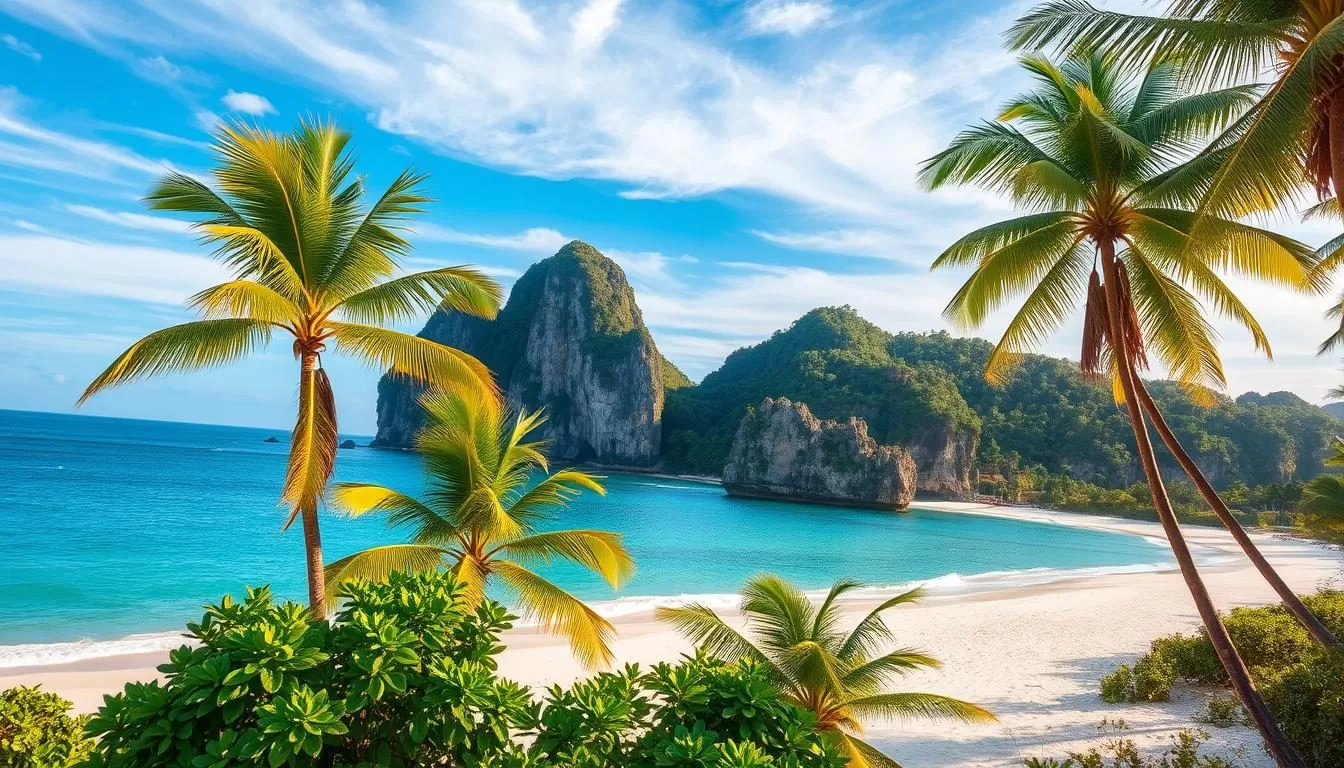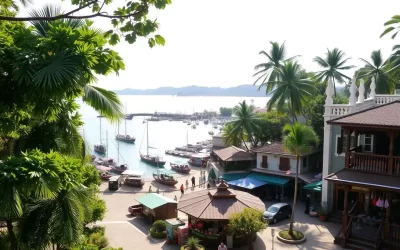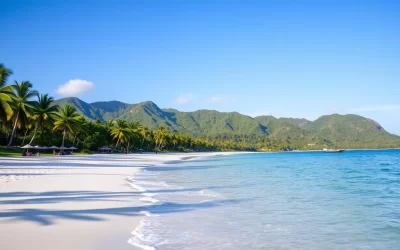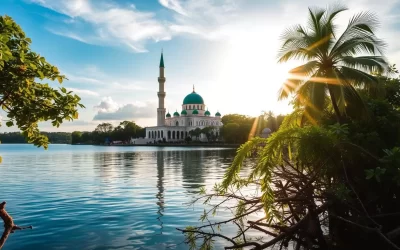You’re about to uncover the secrets of Labuan Island, a Federal Territory of Malaysia that’s often overlooked by travelers. Known as the “Pearl of Borneo,” this island is a treasure trove of experiences, from its duty-free shopping to its rich history and natural beauty.
Located between mainland Malaysia and Brunei, Labuan Island offers a unique blend of modern amenities and historical sites. Its compact size makes it an ideal destination for a 2-3 day getaway, with a diverse range of attractions to explore. You can enjoy the island’s beautiful beaches, go diving, or simply relax in a tranquil atmosphere.
Labuan Island is a place where you can experience the authentic Malaysian culture, away from the typical tourist crowds. With its strategic location and rich offerings, it’s a perfect destination for your next trip.
Discovering Labuan Island: Malaysia’s Hidden Pearl
Labuan Island, a Federal Territory of Malaysia, is an intriguing destination that offers a mix of history, culture, and natural beauty. As you explore this island, you’ll uncover its unique aspects.
Location and Background
Labuan Island is situated 8 kilometers off the coast of Sabah, covering an area of 95 square kilometers. The island is part of the Malaysian Federal Territory, established on April 16, 1984. It comprises one main island and six smaller ones. In 1990, it was declared an International Offshore Financial Center, earning it the nickname “Pearl of Borneo.” This strategic location makes it an attractive place for various activities.
The island’s history and status as a Federal Territory make it distinct from neighboring Sabah. You can explore Labuan’s unique position and understand its evolution over the years.
How to Get to Labuan Island
There are two main ways to reach Labuan Island: by air or by sea. The best choice depends on your starting point. If you’re coming from Brunei, you can take a ferry from the Serasa Ferry Terminal in Muara, which takes about an hour. On the other hand, if you’re traveling from Kota Kinabalu, the ferry journey takes around 5 hours. You can also fly to Labuan Airport, providing you with a convenient way to reach the island.
Understanding the transportation options will help you plan your trip to this Labuan Island effectively.
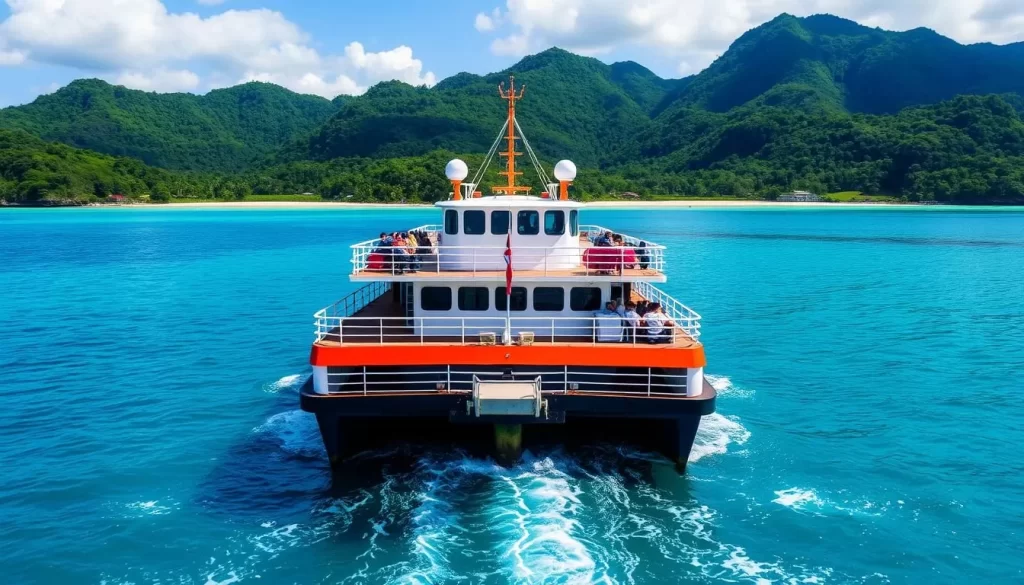
Explore Labuan’s Rich World War II History
As you explore Labuan Island, you’ll uncover a rich history tied to World War II. The island’s strategic location made it a significant player during the war, and today, it stands as a testament to the events that shaped its past.
Labuan War Cemetery

The Labuan War Cemetery is a poignant reminder of the sacrifices made during World War II. It is the largest war memorial in Malaysia, where 3,908 Australian, Indian, and British soldiers are laid to rest. The Commonwealth Graves Commission maintains this site immaculately, ensuring a quiet reflective atmosphere.
Many of those interred here died during the Sandakan-Ranau death marches or in Japanese prison camps. The cemetery is not just a place of remembrance but also a historical site that tells the story of the forces involved in the war.
Peace Park and Surrender Point
Peace Park was built by the Japanese as a gesture of regret for the wartime atrocities. The park features a plaque with the words “Peace is Best” in both Japanese and English, symbolizing the desire for peace. Nearby is Surrender Point, where on September 10, 1945, Japanese Lieutenant General Masao Baba formally surrendered to Australian Major General George Wootten, marking the end of World War II in Borneo.
Visiting these sites provides a deeper understanding of the events that transpired on the island and the significance of the war in the region.
Ramsey Point: MacArthur’s Landing Site
Ramsey Point is historically significant as it was the entry point for the forces led by General Douglas MacArthur on June 10, 1945. This event marked a crucial moment in the Allied liberation of Labuan. Today, visitors can stand at this site and reflect on the history that unfolded.
The story of Labuan during World War II is one of resilience and sacrifice. Exploring these sites allows you to understand the island’s role in the war and its impact on the world.
Dive into Labuan’s Underwater Treasures
Dive into the underwater treasures of Labuan Island, where history meets marine life. Labuan Island is renowned for its exceptional diving experiences, attracting enthusiasts from around the world.
The Four Shipwreck Dive Sites
Labuan Island is home to four WWII shipwreck dive sites that are now a haven for marine life. These wrecks are located at varying distances from Labuan, offering a range of diving experiences.
The Australian Wreck (SS de Klerk), located 14 miles southwest of Pulau Rusukan Besar, is a poignant reminder of the island’s history. It was initially used by the Japanese to transport “comfort women.”
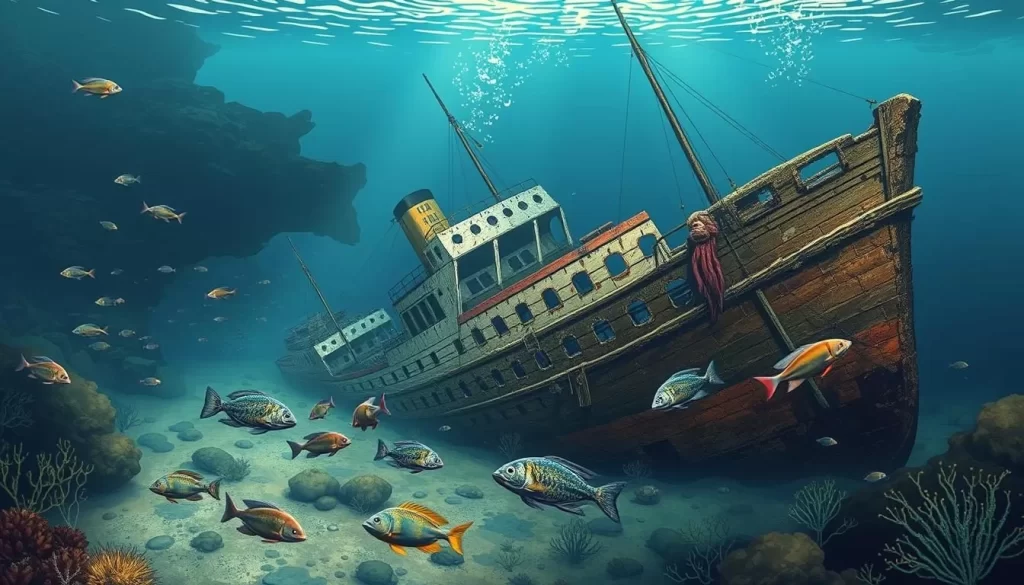
The American Wreck (US Salute), situated about 1.5 km from the Australian Wreck, was bombed by US forces in 1945 and split into two sections. This wreck is a popular diving spot due to its historical significance and the variety of marine life it attracts.
The Cement Wreck (MV Tung Hwang), 21 km east of Pulau Kuraman, got its name from its cargo of cement from Brunei when it sank. This wreck has become a thriving habitat for numerous species of fish and corals.
The Blue Water Wreck (Mabini Padre), a fishing vessel that sank due to fire in 1981, is known for its exceptional visibility of up to 40 meters on clear days, making it a favorite among diving enthusiasts.
Marine Life and Diving Conditions
The waters around Labuan Island, part of the South China Sea, offer diving conditions suitable for beginners to intermediate divers. The depths range from 30-35 meters, ensuring a safe and enjoyable experience.
The wreck sites have become artificial reefs, hosting a diverse array of marine life, including colorful corals, schools of fish, and larger pelagic species. This biodiversity makes Labuan a unique diving spot, where you can experience the rich life beneath the water.
As you explore the underwater world of Labuan, you’ll discover why it’s considered one of Malaysia’s premier diving destinations. The combination of history, wreck sites, and vibrant marine life creates an unforgettable experience.
Visit Labuan’s Fascinating Museums
The island of Labuan boasts an array of intriguing museums that showcase its rich history and culture. You can explore the island’s diverse heritage by visiting these museums, which offer a unique glimpse into Labuan’s past.
Labuan Marine Museum
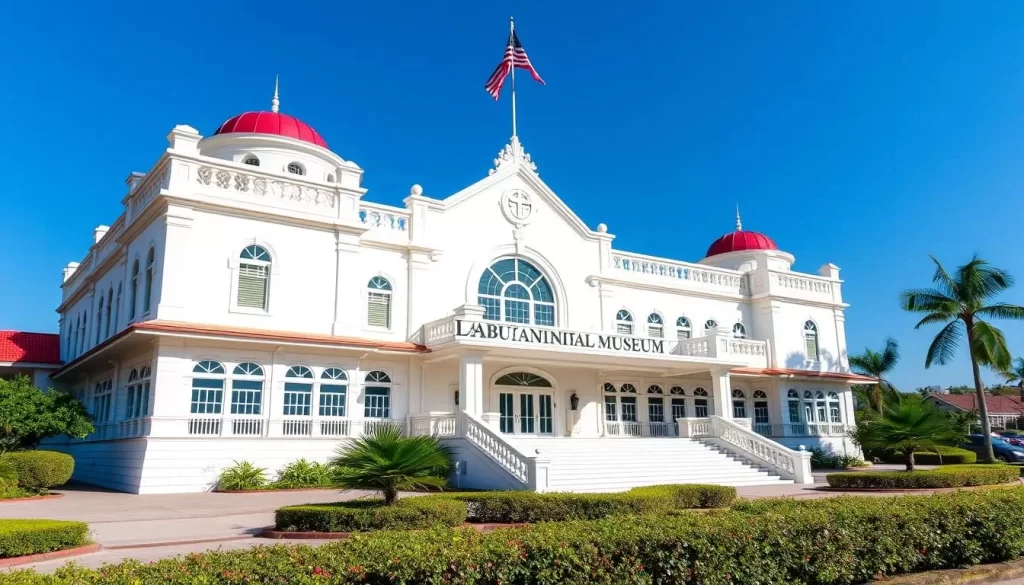
The Labuan Marine Museum is an educational facility that showcases the rich biodiversity of the waters surrounding the island. You can learn about local conservation efforts and marine preservation initiatives through interactive exhibits and informative displays. The museum’s aquarium features live coral specimens, starfish, and other marine creatures native to Labuan’s waters.
It’s best to visit the Labuan Marine Museum during lunchtime when the crowd is smaller, and you can enjoy the air-conditioned environment.
Labuan Museum: Island Heritage
The Labuan Museum is housed in a colonial-era building and chronologically presents the island’s fascinating history. You can examine over 700 historical artifacts that tell the story of Labuan’s development from a coal mining center to an international financial hub.
The museum also provides insight into the island’s strategic importance during World War II and showcases the cultural diversity of Labuan through displays on wedding ceremonies and traditional practices of various ethnic groups.
Both museums offer a comfortable, air-conditioned environment, making them perfect attractions to visit during the hottest part of the day. By visiting these museums, you can gain a deeper understanding of Labuan’s rich history and culture.
The Mysterious Chimney: Labuan’s Enigmatic Landmark
Labuan Island is home to an enigmatic landmark, The Chimney, whose purpose remains unknown to this day. This 105-foot-tall structure, built using approximately 23,000 red bricks imported from England, has sparked numerous theories about its origins and function.
History and Theories
The Chimney was constructed in 1890, and despite its seemingly fragile brick construction, it survived World War II, including both the Japanese invasion and the Allied liberation. Various theories have been proposed to explain its purpose, including that it served as a ventilation shaft for coal mining activities or was part of a since-demolished factory. The coal mining history of Labuan is significant, as it played a crucial role in the island’s early development and economy.
Visitors can explore the different theories and learn about the history surrounding this mysterious structure.
Visiting the Chimney Museum
The Chimney is accompanied by a two-story museum that showcases the history of coal mining on Labuan through dioramas and historical exhibits. Visitors can examine artifacts from the coal mining era, including tools and other items recovered around The Chimney. The museum provides insight into the restoration efforts undertaken in 1990 to preserve this unique historical structure for future generations.
By visiting The Chimney and its museum, you can appreciate this unusual tourist attraction that, despite its uncertain origins, has become an iconic symbol of Labuan Island.
Labuan Island, Malaysia: Best Things to Do for Nature Lovers
Beyond its historical significance, Labuan Island boasts an array of natural attractions that are sure to captivate any visitor. The island is home to several spots that showcase its rich biodiversity and natural beauty.
Labuan Botanical Garden
The Labuan Botanical Garden is a tranquil oasis located on the site of a former government state-owned mansion, west of the War Cemetery. This garden is a fantastic spot to admire the diverse trees and flowers that thrive in Labuan and Southeast Asia. You can wander through the collections of tropical plants, trees, and flowers native to the region, and learn about the garden’s role in conservation and education.
The garden’s peaceful atmosphere offers a refreshing break from the historical sites, making it an ideal visit for those looking to connect with nature.
Labuan Bird Park
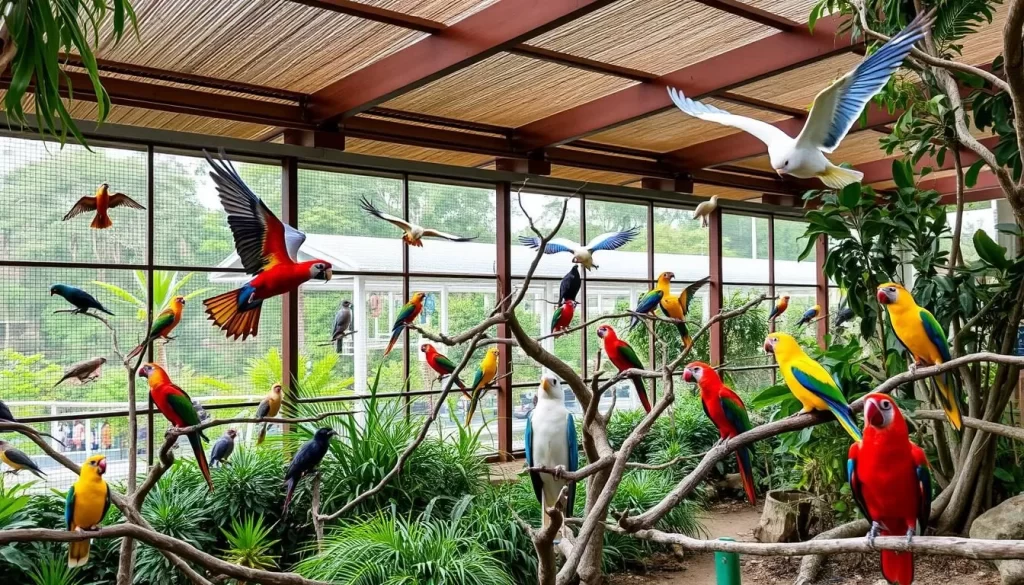
Located on the northeast point of the island, about a 20-minute drive from the Botanical Garden, the Labuan Bird Park is a great spot to visit, especially for families with children. The park is home to a variety of bird species, some of which are free-roaming, while others are housed in spacious, naturalistic enclosures.
You can observe numerous bird species, including native Malaysian birds and exotic birds from around the world. The park’s conservation efforts, including breeding programs for endangered species, add an educational dimension to the visit.
Experience Local Culture at Labuan’s Water Villages
Immerse yourself in the local culture by visiting Labuan’s distinctive water villages. These unique communities are built on stilts above the sea, creating a fascinating blend of traditional and modern ways of life.
Kampung Patau-Patau
Kampung Patau-Patau is one of the two water villages on Labuan Island and is open to visitors. You can experience the daily life of the predominantly Brunei Malay residents and learn about their traditional fishing practices. The village is equipped with basic amenities, including shops and mosques, making it a self-sufficient community.
Visitors can stay overnight in local homestays, allowing for a deeper understanding of the maritime culture that has shaped life in these communities for generations.

Kampung Bebuloh
Kampung Bebuloh, the second water village, offers a more secluded experience for visitors. This village maintains its traditional way of life while adapting to modern influences. You can observe the unique architecture of the stilt houses designed to withstand tidal changes.
The warm hospitality of the villagers welcomes visitors into their unique aquatic neighborhoods, providing an authentic cultural interaction.
Both Kampung Patau-Patau and Kampung Bebuloh provide a unique insight into the water village life, where people live in harmony with the sea. Visiting these villages allows you to appreciate the cultural heritage and the resilience of the community.
Relax on Labuan’s Beautiful Beaches
The beaches of Labuan Island are a hidden gem in Malaysia’s tourism landscape. As an island, you can expect that this Malaysian territory also has some lovely beaches.
Labuan Island is endowed with multiple beaches, each offering a unique experience. You can choose from bustling spots or serene retreats, depending on your preference.
Labuan Beach
Labuan Beach is the most popular beach on the island, attracting both locals and foreigners. It can get crowded, especially during weekend afternoons. However, if you rise early, it’s an ideal spot to watch the sunrise over the South China Sea. To avoid the crowds, plan your visit during the weekdays or early morning.
Pohon Batu Beach
Located on the northwest of the island, Pohon Batu Beach offers a more serene atmosphere. It is renowned for its breathtaking sunset views, making it a perfect spot to relax while vendors sell local snacks, refreshing drinks, and fresh coconuts.
UMS Beach
For those seeking complete tranquility, UMS Beach is the place to be. With minimal commercial development and few shops, it’s advisable to bring your own food and drinks. The beach offers shaded areas, ideal for picnics, tanning, and reading. You can also enjoy the sunset here, in a peaceful environment.
Here’s a comparison of the three beaches:
| Beach Name | Crowd Level | Amenities | Best Time to Visit |
|---|---|---|---|
| Labuan Beach | High | Varied vendors | Early morning |
| Pohon Batu Beach | Moderate | Food and drink vendors | Sunset |
| UMS Beach | Low | Limited | Anytime |

Each beach on Labuan Island has its unique charm, allowing you to choose the perfect spot based on your preferences for activities, amenities, and atmosphere. Whether you’re looking for a vibrant experience or a peaceful retreat, Labuan’s beaches have something to offer.
Shopping and Dining in Duty-Free Labuan
You’ll find some amazing deals on your favorite products when you shop in Labuan. The island’s duty-free status makes it an attractive destination for people looking to snag bargains on a variety of goods, from liquor and cigarettes to perfumes and international food brands.
Duty-Free Shopping Hotspots
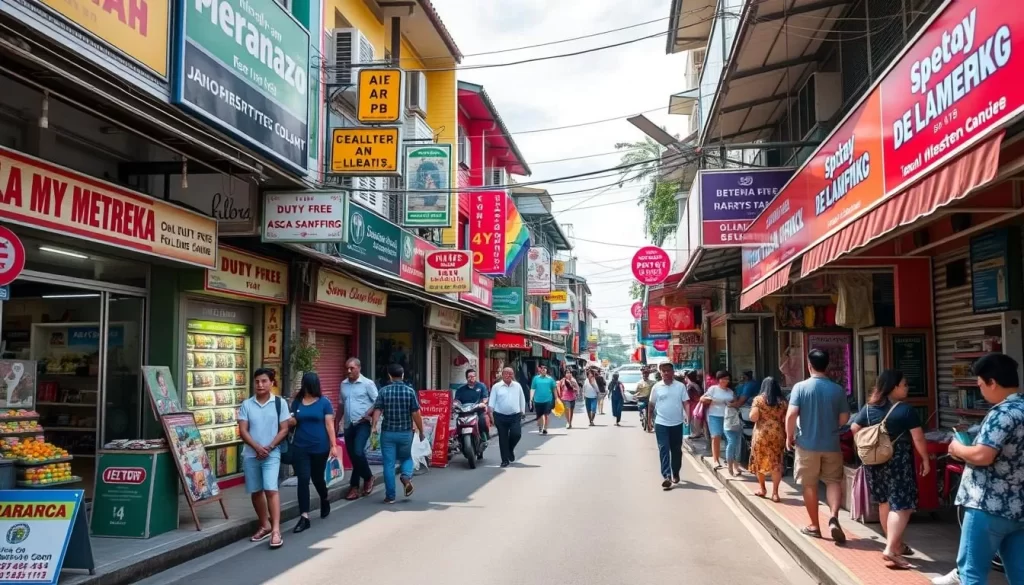
Labuan’s main shopping areas are concentrated near the harbor and along Jalan Merdeka street, where you’ll find a plethora of duty-free businesses operating. You can explore the various shops, compare prices before making a purchase, and take advantage of the discounted rates on offer.
- Take advantage of Labuan’s duty-free status by shopping for discounted liquor, cigarettes, perfumes, and international food brands.
- Explore the main shopping areas near the harbor and along Jalan Merdeka street.
- Compare prices between different shops to ensure you’re getting the best deals on tax-free goods.
Local Cuisine and Seafood Restaurants
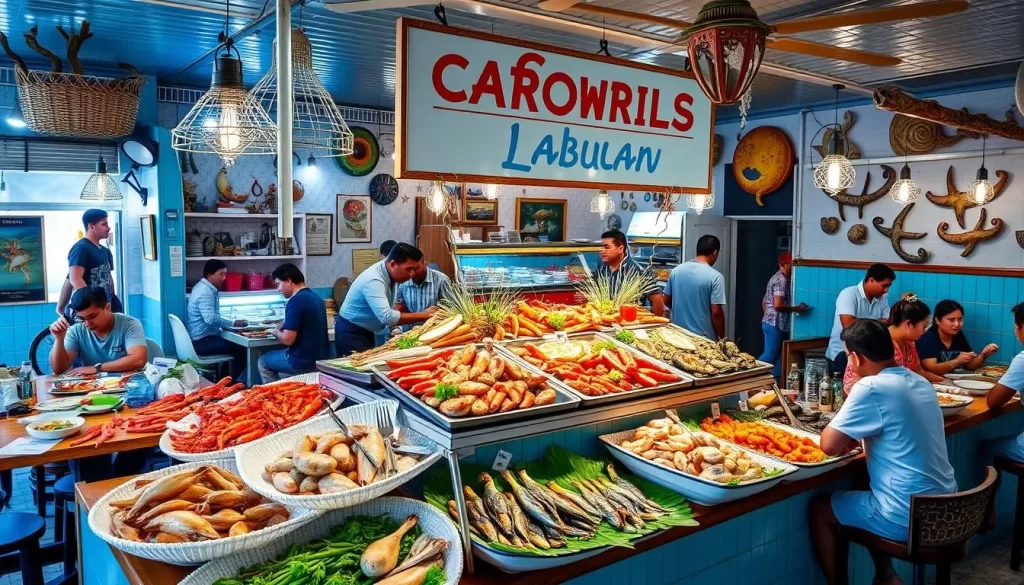
Labuan is renowned for its affordable and delicious food, particularly its seafood. You can sample local Malaysian dishes, as well as Chinese and Indian influences, reflecting the island’s diverse cultural heritage. Be sure to try some of the local specialties, such as “Kolo Mee” and fresh coconut pudding, which showcase the unique flavors of the region.
- Discover Labuan’s reputation for exceptionally affordable seafood, with local restaurants offering fresh catches at prices much lower than mainland Malaysia.
- Visit Mr. Crab Restaurant, a local favorite where you can enjoy fresh crab for as little as RM9 (approximately $2 USD) per crab.
- Experience the relaxed dining atmosphere in town, where locals and visitors mingle in unpretentious seafood restaurants and cafes.
As you explore the island, you’ll find that the food scene is not just about seafood; there’s a variety of local cuisine to try. You can also rent a car to explore the island at your own pace, making the most of your visit to this charming duty-free destination.
Planning Your Labuan Island Getaway
Discover the hidden gem of Labuan Island for an unforgettable experience. With a 2.5-hour flight from Kuala Lumpur, this island is perfect for a weekend getaway. You can choose from various accommodations, including Hotel Labuan Point, which offers a quiet atmosphere and a rooftop bar. Transportation is convenient with affordable Grab car services and car rentals. Plan your 2-3 day itinerary to explore historical sites, natural attractions, and enjoy duty-free shopping. Budget around RM500 per person for a 3-day, 2-night trip, including flights, accommodations, and activities. Make the most of your trip to Labuan Island.
